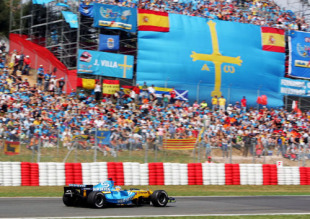- Formula Money
Driving popularity

- Drivers:
- Fernando Alonso
- |
- Michael Schumacher
It's all too easy to mentally separate driving prowess from the business side of F1, but the right driver can make a real impact on the finances of the sport.
Take Michael Schumacher, for example. His return race at the season-opener in Bahrain saw TV audiences in his native Germany soar by 50% compared to the same race in the previous year. According to research firm IFM Sports Marketing Surveys, more than 10.5 million Germans gave up their Sunday morning to watch their hero return to the track after a three-year absence.
As a result the German fans weren't the only people celebrating Schumacher's return. Bernie Ecclestone, chief executive of the Formula One Group, has the most to gain. When Schumacher last raced in 2006, the German TV rights sold for a massive $90 million annually. Since he retired prematurely in 2006 audiences in the country have dropped off sharply and the price of the rights has fallen to $49 million, only a little over half its previous value. If the interest generated by his return doesn't fade, that value will no doubt rise again when Ecclestone renegotiates the German TV contract.
It's no wonder that Ecclestone has come out in Schumacher's support, saying last week that "anybody who criticises Michael is wrong. He deserves better. I would say don't underestimate Michael. Give him time to adapt to the new car and the new tyres." Schumacher means big money and Ecclestone is well aware of that because he's seen it all before.
In 1995, when Schumacher won the title for the second time, the German TV audience had risen to an average of 5.6 million per race. By 2001, the tenth anniversary of Schumacher's entry into the sport, the audiences had gone through the roof and sped past the 10 million mark.
Suddenly the whole of Germany knew about F1 and that was a great thing for the sport. As Schumacher totted up victories, the sport grew rich from the investment of German sponsors, German circuits, German carmakers and even German owners of the sport's commercial rights. Big German brands such as BMW, Allianz and DHL all wanted to be involved in the sport.
It should be called the Schumacher Effect, but it isn't only the German champion that has boosted interest from a particular market in this way. As recently as 2002, F1 wasn't even shown live on Spanish television. But Fernando Alonso has changed all that.

However, although Spain was not interested in F1, F1 was very interested in Spain. As the biggest market in Europe not to have caught on to the sport, it was an important target for Ecclestone who could see its vast untapped potential. When Alonso came along he answered many prayers within the sport as there is no easier way to get a country interested in F1 than to find it a star driver.
It's all too easy to mentally separate driving prowess from the business side of F1, but the right driver can make a real impact on the finances of the sport.
Formula One is now one of the most watched television programmes of the year in Spain. From nothing in 2002, the TV audience has gone from strength to strength. Audiences built steadily between 2003 and 2005, Alonso's first championship year, but they reached a turning point at the Brazilian Grand Prix title finale when an average of 8 million viewers tuned in, peaking at 10.5 million. As Alonso racked up the race wins, the Spanish broadcaster Telecinco reported a 57.2% rise in advertising revenues from F1 broadcasts.
For 2007 another 2,000-seater grandstand was added and attendance hit a record of 141,000. And it isn't just the Grand Prix that has been drawing the crowds. Testing in Spain prior to this season drew more than 30,000 spectators while a Renault F1 Roadshow street event in Seville attracted more than 280,000 people in 2006.
Interest in Alonso has also brought Spanish money to F1 in the form of sponsors. Spanish bank Santander is now one of the biggest spending sponsor in the sport, spending an estimated $50 million annually on sponsoring Alonso's team Ferrari, plus a further $4 million on McLaren and around $25 million more on trackside advertising and race title sponsorships.
But unfortunately for F1, drivers like Alonso and Schumacher don't come along very often and it's not easy to guess where the next major star will come from. Russia, Mexico, India and China are major untapped markets for the sport, but until a driver with a special talent comes along they may stay on the sidelines of the sport.
Christian Sylt and Caroline Reid are authors of Formula Money (www.formulamoney.com)

